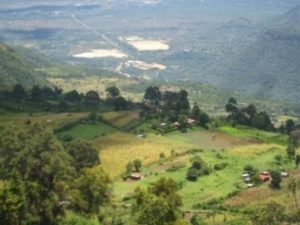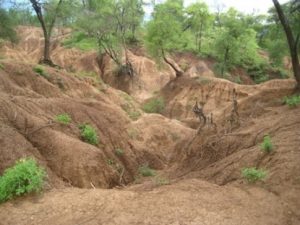71 Trip to Lake Baringo, Kenya
Friday 10 October 2008 Holiday Moi Day Trip to Lake Baringo
I arrived by matatu (group taxi) in Eldoret at 9 AM, Gilbert’s phone was not working, either out of charge or the prepaid credit had expired.
At the Barclays Bank ATM, I withdrew 11,000 shilling. I then went on to the Internet café at the Kivis Hotel. Gilbert called me around 10:30. I got some critical emails completed by the time he called to find out where I was. In about 25 minutes he called again to let me know he was out front in his car.
Gilbert’s right rear tire was low, so we drove over to a tire place to repair the bent rim damaged from repeated trips on the Moi University Road.
I left Gilbert there and followed local Sikh procession that was taking place. About 70 Sikhs were walking on carpets that they placed on the street. As they passed completely over a carpet it was removed and taken to the head of the procession and again place on the ground. This was quite slow and accompanied with lots of Indian music. A huge crowd of Kenyan onlookers watched from the street.

There was a huge flatbed truck with a flatbed trailer parked in font of the temple. These were covered with brightly colored tarpaulins and were decorated with many banners and streamers. A portable stairs had been attached to the back of the trailer and the Sikhs climbed up; the elder men moved forward on the back of the truck while most of the women sat on benches in the trailer. Some women and children were turned away because all the seats were taken and the left the area.
Chanting began and continued for 20 minutes of so when the truck was started and began driving slowly around Eldoret, all the time singing, and chanting continued. Eventually it returned to the temple.
I returned to where Gilbert’s tire was almost ready. In a few minutes we left to find Noel and 3 girls. The had been waiting in city park all this time. I paid 3000 shillings for fuel, and we left Lake Baringo.
We had to pass through the Kerio Valley and requested that we route through the fluorspar mining area where we had passed though when it was too dark to take photos a few weeks before. We left Eldoret on the B 54 road to Kimwarer at the head of the Valley, and we began a steep descent down 20-30 switch backs before we reached the bottom.
 The Kerio Valley (Oct 10, 2008) is a branch of the Rift Valley. The adequate rain and rich volcanic soils on the terrace in the fore ground supports prolific agriculture. The Fluorspar Mining is depicted as light-colored areas on the Valley bottom where is significantly drier.
The Kerio Valley (Oct 10, 2008) is a branch of the Rift Valley. The adequate rain and rich volcanic soils on the terrace in the fore ground supports prolific agriculture. The Fluorspar Mining is depicted as light-colored areas on the Valley bottom where is significantly drier.
We stop frequently to enjoy the landscape. At the bottom we spend some time at Jamrock Gorge where the Kerio River zigzags along a series of fault lines and drops into a 50 meters deep narrow canyon. There are some interesting erosion features in the area. Besides us there were three tour groups visiting the area: Europeans traveling in a 4-wheel drive vehicle, school children on a bus from Eldoret and group of adult Kenyans traveling in a bus.
We continued up the other side of the Valley and climbed to Kabarnet a center for the Tugen people. There Gilbert treated us to lunch. I tasted Noel’s millet “ugali”, called “Wimby”. I really liked it as it reminded me a lot of the “asceda” that I had eaten in the 1970s in the Sudan. I think is a lot better than maize ugali.

Stream erosion repeatedly ravages the dry Kerio Valley bottom.
We continued on over the top of the Tugen Hills and descended into the main Rift Valley. Gilbert kept running into people that he knew, as this was his dissertation field study area. We met several people in Marigat, two of them who will turn out to be significant key informants for our research in traditional agriculture.

Lake Baringo from overlook. Kokwe Island stands out behind resort area on the lakes edge. The angel of the sun gave the lake this strange color.
As we continued north up the Rift Valley, we began to see Lake Barengo in the distance stretching out along the bottom. After 20 kilometers we reach the entrance. Instead of going inside, Gilbert took us a little further along the road to a high look out where we could see the entire lake. We could see all the Islands in the lake, where the park head quarters were and the resort. The only reason to go down there would be to take a tour boat out to see the hippos and crocodiles that occupy certain parts of the lake. We were not interested in that, so we saw the most beautiful part of Barengo from an overlook and never had to pay.
As the late afternoon wore on, we decided to return to Eldoret. We returned to Marigat and contacted two people for our traditional agriculture and as darkness came on, headed back over the Tugen hills, Kerio Valley and up to Iten on the Volcanic Plateau.
Gilbert kept his car moving at rapid rate and in the dark, it was hard to see the road ahead. Just about ten kilometers out of Eldoret a road construction operation had dumped meter high piles of gravel in the left lane. They had left no marker or warning of any sort and we only saw the first sand heap when we were about ten meters from it. There was no way to stop, and we plowed right into it at fifty kilometers per hour. A shower of gravel engulfed the car as we ground to a stop.
My seat belt kept me from flying into the window, but the four in the back had not hooked their seat belts and were knocked around quite a bit. Noel sustained a large bump in the middle of her forehead and became rather nauseated. Everyone was rather shaken up, but no major injuries were occurred. After we cleaned off the car, we realized that the car was still functioning and were still able to drive on to Eldoret.
The next day Gilbert had the damage assessed at around 50,000 shillings ($ 700).

